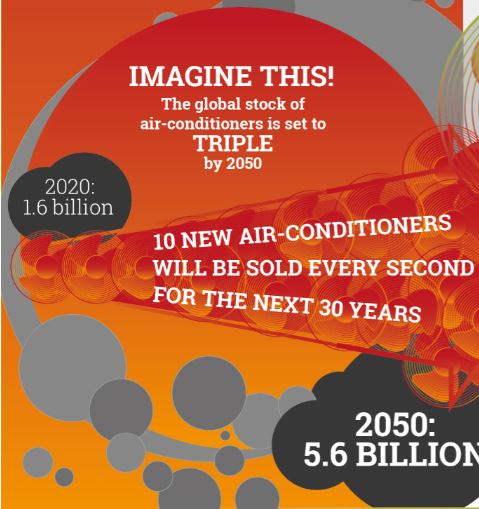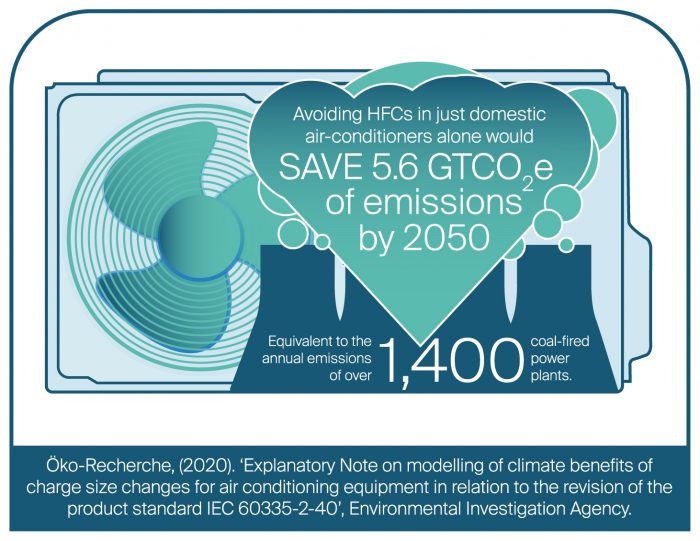As Europe heats up, there’s a new cool kid in town – now the EU must step up its climate change fight
In a year which has seen the real-world consequences of climate catastrophe seldom out of the headlines, the arrival of an efficient, natural refrigerant residential air-con unit on the European market couldn’t be more timely.
July 2021 turned out to be the hottest month ever, August saw an Italian island register the hottest European temperature ever (48.8°C) and the summer saw wildfires ravage Cyprus, Italy, Finland, Greece and Turkey while floods devastated parts of Germany.
The UN Intergovernmental Panel on Climate Change (IPCC) published a sobering (and terrifying) update of climate science earlier this year and warned that these ‘natural’ disasters were exacerbated by human-made climate change and will continue to worsen without immediate action.

Midea receives a UN Industrial Development Organization award for its new room air-con system
Hot on the heels of the IPCC report, UNICEF announced that half the world’s children are at extremely high risk from the impacts of the climate crisis, including from heatwaves, floods, disease and air pollution.
The human body cannot withstand extended extreme temperatures, but it is predicted that by 2100 nearly half of the world’s population will be exposed to deadly heat and humidity for at least 20 days a year – so how will we keep our cool in an ever-warming world?
For many, the answer is to crank up the air-conditioning – for some a luxury, but for others a lifesaver. Yet the rampant proliferation of air-con units is actually further contributing to runaway climate chaos. Not only do they guzzle electricity (often derived from burning fossil fuels), they also contain refrigerant gases that can be thousands of times more potent at warming our atmosphere than carbon dioxide (CO2).
 As temperatures rise, more air-con units are installed, thus pushing global temperatures higher – how can we break this vicious cycle?
As temperatures rise, more air-con units are installed, thus pushing global temperatures higher – how can we break this vicious cycle?
Demand for air-con must be reduced where possible through better city and building design and behaviour change. Then we must shift how we cool ourselves to more innovative and climate-friendly solutions, such as district cooling, community cooling centres and wearable technology.
Where air-con units continue to be necessary, we can dramatically reduce their emissions in two ways.
Firstly, to address their energy consumption (the International Energy Agency estimates that by 2050 space cooling will consume as much electricity as all of China and India today), we need to drastically improve their energy efficiency. The average efficiency of an air-con unit sold today is only one-third of the best technology available. The higher the efficiency, the less electricity is needed for air-con to do its job and keep you cool – better for your wallet and better for the planet.
Secondly, to address the refrigerant gas emissions, we must move away from climate-damaging F-gases such as hydrofluorocarbons (HFCs) and adopt technology using natural or no refrigerants.
Adopting energy-efficient, HFC-free air-conditioning technology will reduce the direct and indirect emissions and allow more people to keep cool in a more sustainable way.
The current refrigerant of choice for most air-con manufacturers in Europe is HFC-32, which has a 100-year global warming potential (GWP) of 771. This means that every tonne of HFC-32 that leaks out warms the atmosphere 771 times more than a tonne of carbon dioxide. The natural refrigerant alternative for residential air-con units is propane, which has a GWP of less than one.
Demand for air-con is growing rapidly and by 2050 the global stock could triple to 5.6 billion units, equating to roughly one unit in two-thirds of all households or 10 new units sold every second for the next 30 years.
This growth would be catastrophic for the climate if we continue to lock in inefficient, high GWP cooling technology. International Energy Agency (IEA) models show that average air-con efficiency can be doubled, reducing energy demand by 45 per cent and halving emissions by 2050. Öko-Recherche found that switching residential air-con units from HFCs to propane could avoid 5.6 gigatonnes of CO2e emissions – emissions equal to 1,400 coal-fired power stations running for a year.
 So, finally, there’s good news – after a long wait, an efficient, natural refrigerant residential air-con unit has been launched in the European market with Chinese manufacturer Midea delivering the first shipment of its All Easy R-290 propane units to Germany.
So, finally, there’s good news – after a long wait, an efficient, natural refrigerant residential air-con unit has been launched in the European market with Chinese manufacturer Midea delivering the first shipment of its All Easy R-290 propane units to Germany.
Midea’s units are the only room air-con system to have been awarded Germany’s Blue Angel certification, awarded to technology which is HFC-free and achieves high energy efficiency levels (seasonal energy efficiency ratio of seven or higher and seasonal coefficient of performance of at least 4.6). These units offer significant reductions in both direct and indirect emissions.
A further positive development for the uptake of climate-friendly propane units could be expected next year as new standards for these products are voted on by the International Electrotechnical Commission (IEC).
As propane is a flammable gas, the amount used in residential applications is restricted by outdated industry safety standards that have been dominated for years by companies which have an interest in keeping natural refrigerant technologies off the global market.
The upcoming vote could see the safe charge size of flammable gases such as propane increased from 150g to 500g, which would offer opportunities for greater energy efficiencies and greater market access for these technologies.
EIA’s Climate Team has long advocated a switch to natural refrigerants in residential air-conditioning and now that Midea has officially launched its energy efficient HFC-free products on the market, the European Commission must seriously consider a ban on HFCs in new residential room air-con.
The F-Gas Regulation that governs the phase-down of HFCs is currently under review and ambition needs to be ramped up in line with Europe’s climate targets and EU pledges under the Paris Agreement.
In the current Regulation, there is a ban on HFCs with a GWP of 750 or higher in new residential air-con units, due to begin in 2025. Even before the ban has started, this has had a big impact, with new air-con models containing HFC-32 flooding the European market. With the recent commercial availability of the much more climate-friendly propane units, a new ambitious ban on HFCs in room air-conditioners is warranted.
The technology exists, the science is clear – now we must push for the political will to take meaningful action.




